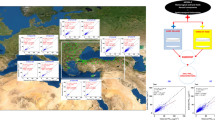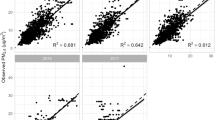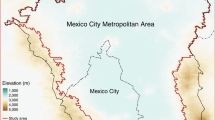Abstract
Air pollution caused by fine particulate matter (PM2.5) may affect people’s health. At present, aerosol optical depth (AOD) products have been used to estimate PM2.5 concentrations. However, AOD always has a low coverage rate. High-resolution products cannot provide a wide range of data. The purpose of this study was to deal with the missing data problem using the interpolation technique and to estimate high-resolution PM2.5 concentrations by fitting the spatial and temporal variations of AOD and PM2.5. Firstly, we developed a gradient boosting model (XGBoost) to fill in the missing values. Secondly, we corrected the altitude and humidity of meteorological variables. We then used the mixed-effects model with the gap-filling AOD data to estimate the PM2.5 concentrations in this study area. Finally, we obtained the complete PM2.5 concentrations picture. The AOD coverage rate reached 100% after model estimation. Meanwhile, the estimation results of PM2.5 concentrations were also validated and the model worked well. The results indicate that it is necessary to fill in the missing values of AOD data for PM2.5 estimations. This study can provide complete AOD data, which makes the results of PM2.5 estimations more accurate and has some research value.






Similar content being viewed by others
Data Availability
The datasets used and/or analyzed during the current study are available from the corresponding author on reasonable request.
References
Chen N, Yang M, Du W, Huang M (2021) PM2.5 estimation and spatial-temporal pattern analysis based on the modified support vector regression model and the 1 km resolution MAIAC AOD in Hubei, China. ISPRS Int J Geo Info 10(1):31
Chen T, Guestrin C (2016) XGBoost: A Scalable Tree Boosting System. ACM, ACM
Chen Z, Zhang T, Zhang R, Zhu Z, Yang J, Chen P, Ou C, Guo Y (2019) Extreme gradient boosting model to estimate PM2.5 concentrations with missing-filled satellite data in China. Atmos Environ 202:180–189
Ding Y, Chen Z, Lu W, Wang X (2021) A CatBoost approach with wavelet decomposition to improve satellite-derived high-resolution PM2.5 estimates in Bei**g-Tian**-Hebei. Atmos Environ 249:118212
Han W, Tong L, Chen Y, Li R, Yan B, Liu X (2018) Estimation of high-resolution daily ground-level PM2.5 concentration in Bei**g 2013–2017 using 1 km MAIAC AOT data. Applied Sciences 8(12):2624
Han Y, Lam JC, Li VO, Reiner D (2021) A Bayesian LSTM model to evaluate the effects of air pollution control regulations in Bei**g, China. Environ Sci Policy 115:26–34
He Q, Gu Y, Zhang M (2020) Spatiotemporal trends of PM2.5 concentrations in central China from 2003 to 2018 based on MAIAC-derived high-resolution data. Environ Int 137:105536
Hu Kang, Kumar Kanike Raghavendra, Kang Na, Boiyo Richard, Wu **wen (2018) Spatiotemporal characteristics of aerosols and their trends over mainland China with the recent Collection 6 MODIS and OMI satellite datasets. Environmental Science and Pollution Research 25(7):6909–6927. https://doi.org/10.1007/s11356-017-0715-6
Guo Y, Nan, Feng Sundar A, Christopher **, Kang F. Benjamin, Zhan Song, Hong (2014) Int J Remote Sens 35(17):6522–6544. https://doi.org/10.1080/01431161.2014.958245
Huang Keyong, **ao Qingyang, Meng **a, Geng Guannan, Wang Yujie, Lyapustin Alexei, Gu Dongfeng, Liu Yang (2018) Predicting monthly high-resolution PM2.5 concentrations with random forest model in the North China Plain. Environmental Pollution 242:675–683. https://doi.org/10.1016/j.envpol.2018.07.016
Kloog I, Sorek-Hamer M, Lyapustin A, Coull B, Wang Y, Just AC, Broday DM (2015) Estimating daily PM2.5 and PM10 across the complex geo-climate region of Israel using MAIAC satellite-based AOD data. Atmos Environ 122:409–416
Lee HJ (2019) Benefits of high resolution PM2.5 prediction using satellite MAIAC AOD and land use regression for exposure assessment: California examples. Environ Sci Technol 53(21):12774–12783
Li L, Franklin M, Girguis M, Lurmann F, Wu J, Pavlovic N, Habre R (2020) Spatiotemporal imputation of MAIAC AOD using deep learning with downscaling. Remote Sens Environ 237:111584
Li Lianfa, Franklin Meredith, Girguis Mariam, Lurmann Frederick, Wu Jun, Pavlovic Nathan, Breton Carrie, Gilliland Frank, Habre Rima (2020) Spatiotemporal imputation of MAIAC AOD using deep learning with downscaling. Remote Sensing of Environment 237:111584. https://doi.org/10.1016/j.rse.2019.111584
Lv B, Hu Y, Chang HH, Russell AG, Bai Y (2016) Improving the accuracy of daily PM2.5 distributions derived from the fusion of ground-level measurements with aerosol optical depth observations, a case study in North China. Environ Sci Technol 50(9):4752–4759
Lyapustin A, Wang Y, Korkin S, Huang D (2018) MODIS collection 6 MAIAC algorithm. Atmos Meas Tech 11(10):5741–5765
Ma Z, Hu X, Huang L, Bi J, Liu Y (2014) Estimating ground-level PM2.5 in China using satellite remote sensing. Environ Sci Technol 48:7436e7444
Ma X, Wang J, Yu F, Jia H, Hu Y (2016) Can MODIS AOD be employed to derive PM2.5 in Bei**g-Tian**-Hebei over China? Atmos Res 181:250e256
Natunen A, Arola A, Mielonen T, Huttunen J, Komppula M, Lehtinen KEJ (2010) A multi-year comparison of PM2.5 and AOD for the Helsinki region. Boreal Environ Res 15:6
Park S, Shin M, Im J, Song CK, Kim SK (2018) Estimation of ground level particulate matter concentrations through the synergistic use of satellite observations and process-based models over South Korea. Atmos Chem Phys 19(2):1097–1113
Shen X, Bilal M, Qiu Z, Sun D, Wang S, Zhu W (2019) Long-term spatiotemporal variations of aerosol optical depth over yellow and bohai sea. Environ Sci Pollut Res 26:7969–7979
Tao JH, Zhang MG, Chen LF, Wang ZF, Lin SU, Cui GE et al (2013) A method to estimate concentrations of surface-level particulate matter using satellite-based aerosol optical thickness. Science China Earth Science 56(008):1422–1433
Tian X, Liu Q, Li X, Wei J (2021) Validation and comparison of MODIS C6.1 and C6 aerosol products over Bei**g, China. Remote Sensing 10(12):2021
Van Donkelaar A, Martin RV, Brauer M, Hsu NC, Kahn RA, Levy RC, Winker DM (2016) Global estimates of fine particulate matter using a combined geophysical-statistical method with information from satellites, models, and monitors. Environ Sci Technol 50(7):3762–3772
van Donkelaar A, Randall V, Martin Robert JD, Spurr Richard T, Burnett (2015) Environ Sci Technol 49(17):10482–10491. https://doi.org/10.1021/acs.est.5b02076
Wang YS, Yao L, Wang LL, Liu ZR, Ji DS, Tang GQ, Zhang JK, Sun Y, Hu B, **n JY (2014) Mechanism for the formation of the January 2013 heavy haze pollution episode over central and eastern China. Sci China Earth Sci 57:14–25
Wang Y, Jiang H, Zhang S, Xu J, Lu X, ** J, et al (2016) Estimating and source analysis of surface PM2.5 concentration in the Bei**g–Tian**–Hebei region based on MODIS data and air trajectories. Int J Remote Sens 37(19–20):4799–4817
Wang Z, Zhou Y, Zhao R, Wang N, Biswas A, Shi Z (2021) High-resolution prediction of the spatial distribution of PM2.5 concentrations in China using a long short-term memory model. J Clean Prod 297:126493
Wei J, Huang W, Li Z, Xue W, Peng Y, Sun L, Cribb M (2019) Estimating 1-kmresolution PM2.5concentrations across China using the space-time random forest approach. Rem Sens Environ 231
**ao Q, Wang Y, Chang HH, **a M, Yang L (2017) Full-coverage high-resolution daily PM2.5 estimation using MAIAC AOD in the Yangtze River Delta of China. Remote Sens Environ 199:437–446
**ao Q, Geng G, Cheng J, Liang F, Li R, Meng X, He K (2021) Evaluation of gap-filling approaches in satellite-based daily PM2.5 prediction models. Atmos Environ 244:117921
Xue T, Zheng Y, Tong D, Zheng B, Li X, Zhu T, Zhang Q (2019) Spatiotemporal continuous estimates of PM2.5 concentrations in China, 2000–2016: a machine learning method with inputs from satellites, chemical transport model, and ground observations. Environ Int 123:345–357
Yang J, Hu M (2018) Filling the missing data gaps of daily MODIS AOD using spatiotemporal interpolation. Sci Total Environ 633:677–683. https://doi.org/10.1016/j.scitotenv.2018.03.202
Yang Z, Zdanski C, Farkas D, Bang J, Williams H (2020) Evaluation of aerosol optical depth (AOD) and PM2.5 associations for air quality assessment. Remote Sens Appl Soc Environ 20:100396
You W, Zang Z, Zhang L, Li Y, Pan X, Wang W (2016) National-scale estimates of ground-level PM2.5 concentration in China using geographically weighted regression based on 3 km resolution MODIS AOD. Rem Sens 8:184
Zamani Joharestani M, Cao C, Ni X, Bashir B, Talebiesfandarani S (2019) PM2.5 prediction based on random forest, XGBoost, and deep learning using multisource remote sensing data. Atmosphere 10(7):373
Zhang X, Chu Y, Wang Y, Zhang K (2018) Predicting daily PM2.5 concentrations in Texas using high-resolution satellite aerosol optical depth. Sci Total Environ 631:904–911
Zhang T, He W, Zheng H, Cui Y, Song H, Fu S (2021) Satellite-based ground PM2.5 estimation using a gradient boosting decision tree. Chemosphere 268:128801
Zhao C, Wang Q, Ban J, Liu Z, Zhang Y, Ma R, Li T (2020) Estimating the daily PM2.5 concentration in the Bei**g-Tian**-Hebei region using a random forest model with a 0.01× 0.01 spatial resolution. Environ Int 134:105297
Zheng C, Zhao C, Zhu Y, Wang Y, Shi X, Wu X et al (2017) Analysis of influential factors for the relationship between PM2.5 and AOD in Bei**g. Atmospheric Chem Phys 17(21):13473–13489
Acknowledgements
The MODIS data were obtained from NASA. We would like to thank the team of AERONET for the hard work. We acknowledged that China National Environmental Monitoring Center provided the PM2.5 data from ground monitoring stations. We are thankful to the European Center for Medium-term Weather Forecast for the meteorological data.
Funding
This research is supported by the National Key Research and Development Program of China under Grant 2016YFC0400903, and the Fundamental Research Funds for the Central Universities under Grant DUT20LAB114.
Author information
Authors and Affiliations
Contributions
Min Han: supervision, writing-review and editing. Shuqin Jia: writing-original draft, investigation, conceptualization. Chengkun Zhang: data curation, software, methodology.
Corresponding author
Ethics declarations
Ethics approval and consent to participate
Not applicable.
Consent for publication
Not applicable.
Competing interests
The authors declare no competing interests.
Additional information
Publisher's Note
Springer Nature remains neutral with regard to jurisdictional claims in published maps and institutional affiliations.
Rights and permissions
About this article
Cite this article
Han, M., Jia, S. & Zhang, C. Estimation of high-resolution PM2.5 concentrations based on gap-filling aerosol optical depth using gradient boosting model. Air Qual Atmos Health 15, 619–631 (2022). https://doi.org/10.1007/s11869-021-01149-w
Received:
Accepted:
Published:
Issue Date:
DOI: https://doi.org/10.1007/s11869-021-01149-w




